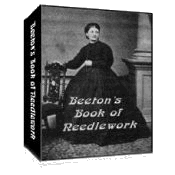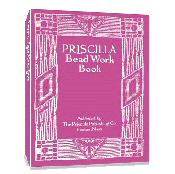Twisted Outline Stitch
The Twisted Outline Stitch is one of the rich stitches and belongs to elaborate work.
It bears very much the same relation to opus plumarium (feather stitch) in embroidering stems etc. that the Kensington outline does to long and short work.
The Twisted Outline Stitch is similar to the Bulgarian, in that it consists of several parallel rows of Outline Stitches.
This stitch can be worked only on a framed material.
A double thread is best adapted to the work. The thread should be brought up on the outline its full length above the framed fabric and the needle turned in the fingers until the thread is well twisted, then holding the twisted thread over the forefinger of the left hand send the needle down a quarter of an inch in advance on the line; bring it up again close beside the stitch thus laid, about a third back on its length, then send it down again in advance.
It clings to the surface on which it is placed because of the tight twisting of the thread as one proceeds to lay the stitches.
The width of the stem should be covered with parallel lines of these stitches.
One line is not satisfactory, but two or more lie well together. The stitches must be taken uniformly all on one side of each line.
The stitches are much longer than the regular Outline Stitches, and the result of the twisting is to give a ribbed effect, which is often of value. See illustrations below.


The suggestion of twisting may be applied in other ways, especially inlaying long stitches such as the cross-bar and diaper work. Usage is limited only by the embroiderer’s creativity.
Return to top of Twisted Outline Stitch.
Return to Embroidery Stitches page.
Return to Home page.



 433 pages!
433 pages!

